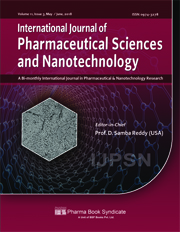Formulation and Evaluation of Lercanidipine Loaded Self-Nanoemulsifying Drug Delivery System
DOI:
https://doi.org/10.37285/ijpsn.2018.11.3.5Abstract
In the present study, we sought to improve the solubility and bioavailability of lercanidipine HCl using self-nanoemulsifying drug delivery systems (SNEDDS). The extent of self-emulsification was checked with various oils with suitable surfactants and co-surfactants. The final optimized formulation contained Caproyl 90, Tween 80 and Labrosol as oil, surfactant and co-surfactant respectively. Based on lercanidipine solubility analysis, ternary phase diagrams were constructed for optimizing the system. The formulations were evaluated for FTIR studies, scanning electron microscopy (SEM), solubility, droplet size determination, zeta potential and stability studies. The droplet size was found to be 5.1 nm and Z-Average of 14.6 nm. The zeta potential of the optimized formulation (F16) was found to be -19.7 mV. In vitro drug release from SNEDDS was significantly higher than pure drug. Hence, lercanidipine SNEDDS is an optimum formulation strategy to enhance the solubility and oral bioavailability of this poorly water-soluble drug.
Downloads
Metrics
Keywords:
Lercanidipine, Caproyl 90, Tween 80, Labrosol, Solubility, SNEDDSDownloads
Published
How to Cite
Issue
Section
References
Borghi C (2005). Lercanidipine in Hypertension. Vasular Health and Risk Management 1(3): 173-182.
Chirag R, Neha J, Jitendra P and Upadhyay UM (2012). Enhanced oral bioavailability of olmesartan by using novel solid SEDDS. International Journal of Advanced Pharmaceutics 2: 82-92.
Bhikshapathi DVRN, Madhukar P, Dilip KB and Aravind KG (2015). Formulation and characterization of Pioglitazone HCl self-emulsifying drug delivery system. Scholars Research Library 5(2): 292-305.
Gupta AK, Mishra DK and Mahajan SC (2011). Preparation and in-vitro evaluation of self-emulsifying drug delivery system of antihypertensive drug Valsartan. International Journal of Pharmacy and Life Sciences 2(3): 633-639.
Gurjeet K, Pankaj C and Harikumar SL (2013). Formulation Development of Self Nanoemulsifying Drug Delivery System (SNEDDS) of Celecoxib for Improvement of Oral Bioavailability. Pharmacophore 4(4): 120-133.
Herbette LG, Vecchiarelli M and Sartani A (1998). Lercanidipine: short plasma half-life, long duration of action and high cholesterol tolerance updated molecular model to rationalize its pharmacokinetic properties. Blood Press Suppl 2: 10-17.
Lalit KT and Mohan LK (2014). Stability Study and In-vivo Evaluation of Lornoxicam Loaded Ethyl Cellulose Microspheres. International Journal of Pharmaceutical Sciences and Drug Research 6(1): 26-30.
Patel J, Kevin G, Anjali P, Mihir R and Navin S (2011). Design and development of a self-nanoemulsifying drug delivery system for Telmisartan for oral drug delivery. International Journal of Pharmaceutical Investigation 1(2): 112-118.
Patwekar SL and Baramade MK (2012). Controlled release approach to novel multiparticulate drug delivery system, International Journal of Pharmacy and Pharmaceutical Sciences 4(3): 757-763.
Rajinikanth PS, Neo WK and Sanjay G (2012). Self-nanoemulsifying drug delivery systems of Valsartan: preparation and in-vitro characterization. International Journal of Drug Delivery 4(2): 153-163.
Ruan G and Feng SS (2003). Preparation and Characterization of Poly (lactic acid) - poly (ethylene Glycol)-poly lactic acid (PLA-PEG-PLA) microspheres for the controlled release of Paclitaxel. Biomaterials 24: 5307-44.
Sabbatini M, Leonardi A and Testa R (2002). Effects of dihydropyridine type Ca 2+ antagonists on the renal arterial tree in spontaneously hypertensive rats. Cardiovasc Pharmacol 39: 39-48.
Sermkaew N, Ketjinda W, Boonme P, Phadoongsombut N and Wiwattanapatapee R (2013). Liquid and solid self-microemulsifying drug delivery systems for improving the oral bioavailability of andrographolide from crude extract of Andrographis paniculata. European Journal of Pharmaceutical Sciences 50(3-4): 459-66.
Shaikh FI and Patel VB (2015). Enhancement of dissolution of Lercanidipine Hydrochloride using solid dispersion technique. Research Journal of Recent Sciences 4: 299-307.
Sharma M, Sharma R and Jain DK (2016). Nanotechnology based approaches for enhancing oral bioavailability of poorly water soluble antihypertensive drugs. Scientifica 1: 1-11.
Vanitha SS and Subhashini NJP (2013). Novel self-nanoemulsion drug delivery system of fenofibrate with improved bio-availability. Int J Pharm Bio Sci 4(2): 511-521.
Vijaykumar N, Zhijun W and Guru VB (2016). Pharmacokinetic Evaluation of Improved Oral Bioavailability of Valsartan: Proliposomes versus Self-nanoemulsifying drug delivery systems. AAPS Pharm Sci Tech 17(4): 851-862.
Zhongcheng K, Xuefeng H and Xiao-bin J (2016). Design and optimization of self-nanoemulsifying drug delivery systems for improved bioavailability of cyclovirobuxine D. Drug Design Development and Therapy 10: 2049-2060.






